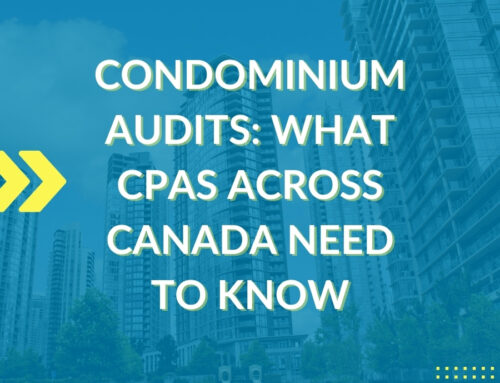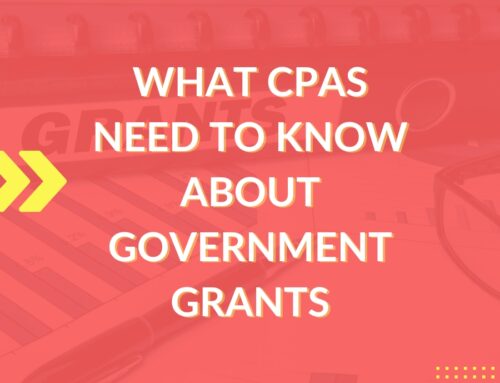Each year, the Accounting Standards Board (AcSB) conducts a process to make minor modifications to Accounting Standards for Private Enterprises (ASPE) and Accounting Standards for Not-for-Profit Organizations (ASNPO) in Part II of the CPA Canada Handbook – Accounting. According to the AcSB, the yearly improvement process seeks to:
- explains conventional guidelines or phrasing; or
- corrects relatively minor unintentional implications, disputes, or omissions.
The AcSB issued an exposure draft in October 2020 proposing the 2021 Annual Improvements to ASPE. These improvements were published on April 1, 2021 and are applicable for annual financial statements for fiscal years beginning on or after January 1, 2022, with earlier application permitted.
In this article, we will summarize those changes and what they mean for practitioners and their private and not-for-profit clients.
Section 1500: First-time adoption
Section 1500 applies to an entity’s first set of financial statements produced in line with ASPE. Some stakeholders expressed concern that it is unclear whether enterprises that used ASPE in a previous reporting period but whose most recent annual financial statements were not prepared per ASPE can use Section 1500 again. The proposed modifications specify that those entities can implement Section 1500 in keeping with Section 1506 – Accounting Changes retroactively.
Section 1510: Current assets and current liabilities
Current assets and current liabilities, paragraph 1510.11 stipulates that amounts owed on loans from directors, officers, and shareholders, as well as amounts owed to parent and other related businesses, be reflected separately on the balance sheet, whether on account of a loan or otherwise.
Some stakeholders believed that reporting these numbers in the notes to the financial statements fulfils the needs of consumers. The proposed amendment allows these items to be shown individually on the balance sheet or disclosed in the notes to the financial statements or supporting schedules.
Section 1540: Cash-flow statement
The cash flow statement, paragraph 1540.47(d), requires an entity to report, in aggregate, the total assets, other than cash or cash equivalents, and total liabilities acquired or disposed of during the period, in respect of both business combinations and disposals of business units. Due to disclosure obligations in other Sections, several stakeholders have highlighted that information that could inform decisions in this area is available. This disclosure obligation is removed from paragraph 1540.47 by the proposed change.
Section 3856: Financial instruments
In Section 3856, Example 3 depicts the first measurement of common shares and a note receivable issued between related parties in return for property and a trade receivable. In this example, the common shares issued by Company G are valued at $25,000 in Situations I and II, where the transaction is valued at the carrying or exchange amount of land, respectively.
Some stakeholders feel the illustrative example conflicts with Example 3 in Related Party Transactions, Section 3840, which assesses common shares issued by Company B (Buyer) at different values in exchange and carrying amount circumstances. The proposed modification to Example 3 in Section 3856 specifies that Company G assigns the same value of $25,000 whether the transaction is valued at the carrying amount or the exchange amount of the land.
Amendments to ASPE
In June 2019, Section 3051, Investments and Section 3465, Income Taxes were amended in the CPA Canada Handbook – Accounting, with the amendments effective for years beginning or after January 1, 2020.Due to the COVID-19 pandemic, the AcSB deferred the effective date of the amendments to these sections by one year to be effective for years beginning on or after January 1, 2021.
Section 3051: Investments
Section 3051 was updated in December 2016 to include guidance on applying the cost approach to an investment subject to considerable influence, as per paragraph 3051.07A. Section 3056, Interests in Joint Arrangements, permits an investor to account for an interest in a jointly controlled company using either the equity method or the cost method, as specified in Section 3051.
In practice, it was unclear whether the instruction on using the cost approach in paragraph 3051.07A also applied to stakes in jointly owned businesses. The Amendments clarify that the guideline in paragraph 3051.07A does apply to a cost-method interest in a jointly owned firm.
Section 3400: Revenue
The AcSB amended ASPE Section 3400 Revenue in December 2019, with the amendments apply to Not-for-Profit Organizations where relevant. Section 3400 was modified to offer further clarity on how to apply the obligations in this Section relating to:
- Percentage of completion method – The percentage of completion approach provides additional advice for revenue recognition, such as assessing the degree of completeness using either input or output measurements.
- Multiple-element arrangements – The amendments provide guidelines on assigning consideration in multiple-element arrangements to distinct units of account on a relative stand-alone selling price basis, as well as techniques for calculating the stand-alone selling price where it is not readily observable.
- Reporting revenue gross or net – The modifications include indications to consider when deciding whether to report revenue as gross or net, such as a gross indicator where an entity has general inventory risk.
- Bill and hold arrangements – The revised standard includes criteria for deciding whether to recognize revenue for a bill and hold arrangement, such as when a client has made a firm commitment to purchase goods.
- Up-front non-refundable fees or payments – the amended standard clarifies when to recognize revenue for upfront non-refundable fees or payments.
Section 3465: Income taxes
When applying the future income taxes method, Section 3465 currently mandates that future income tax assets and liabilities be categorized as current or non-current. The amendments require that all future income tax assets and liabilities be classified as non-current, regardless of whether the temporary differences that produce them are reversed. To eliminate any references to the current categorization of future income tax assets and liabilities, substantive changes were also made to Part II of the Handbook’s Section 1510, Current Assets and Current Liabilities.
The presentation of future income tax assets and liabilities has been simplified because of this modification. It is also compatible with International Accounting Standard (IAS) 12, Income Taxes in Part I (International Financial Reporting Standards) of the Handbook.
As part of the changes, the illustrative example in Section 3465 was also eliminated. Section 3465.14(f) provides guidelines on how to account for the tax implications of qualified capital property (ECP). Effective January 1, 2017, the ECP requirements in Section 14 of the Canadian Income Tax Act were repealed and replaced by new Class 14.1 of Schedule II to the Canadian Income Tax regulations. As a result, the illustrative example is no longer applicable, and the Amendments delete it from Section 3465.
Consultation Paper on Contributions – Revenue Recognition and Related Matters
The AcSB issued a consultation paper in May 2020 that examines the prospect of significant changes to how Not-For-Profit Organizations (NFPOs) account for donations. The AcSB concluded that the present accounting alternatives add additional complexity to NFPO accounting and occasionally limit the comparability of financial statements of similar NFPOs, which led to the proposed adjustment.
The consultation paper explores a core idea: whether there is any benefit in accounting for donations depending on their characteristics rather than the existing method of adopting a one-size-fits-all policy option for all contributions. External limits on what the sums can be used for and stipulations requiring the return of excess funds at a specific point in time are examples of such qualities. The review also looks at how donations for the acquisition of capital assets, endowments, and bequests are treated.
The Consultation Paper was closed for comment on December 31, 2020 and the AcSB is currently reviewing and deliberating stakeholder feedback.
More Information
The modifications to Accounting Standards for Private Enterprises (ASPE) and Accounting Standards for Not-for-Profit Organizations (ASNPO) are designed to provide additional clarity in several areas. It is vital that accounting professionals fully understand these modifications and any potential implications for their private sector and not-for-profit clients.
For an in-depth overview of the updates, AJAG offers an online course that provide additional details on each modified Section. Click here to read the course overview and details on how to register.
AJAG also offers a comprehensive selection of over 100 professional development courses in tax, accounting, and assurance. Click here to view our full course selection or contact us to discuss the courses that best fit your needs.






